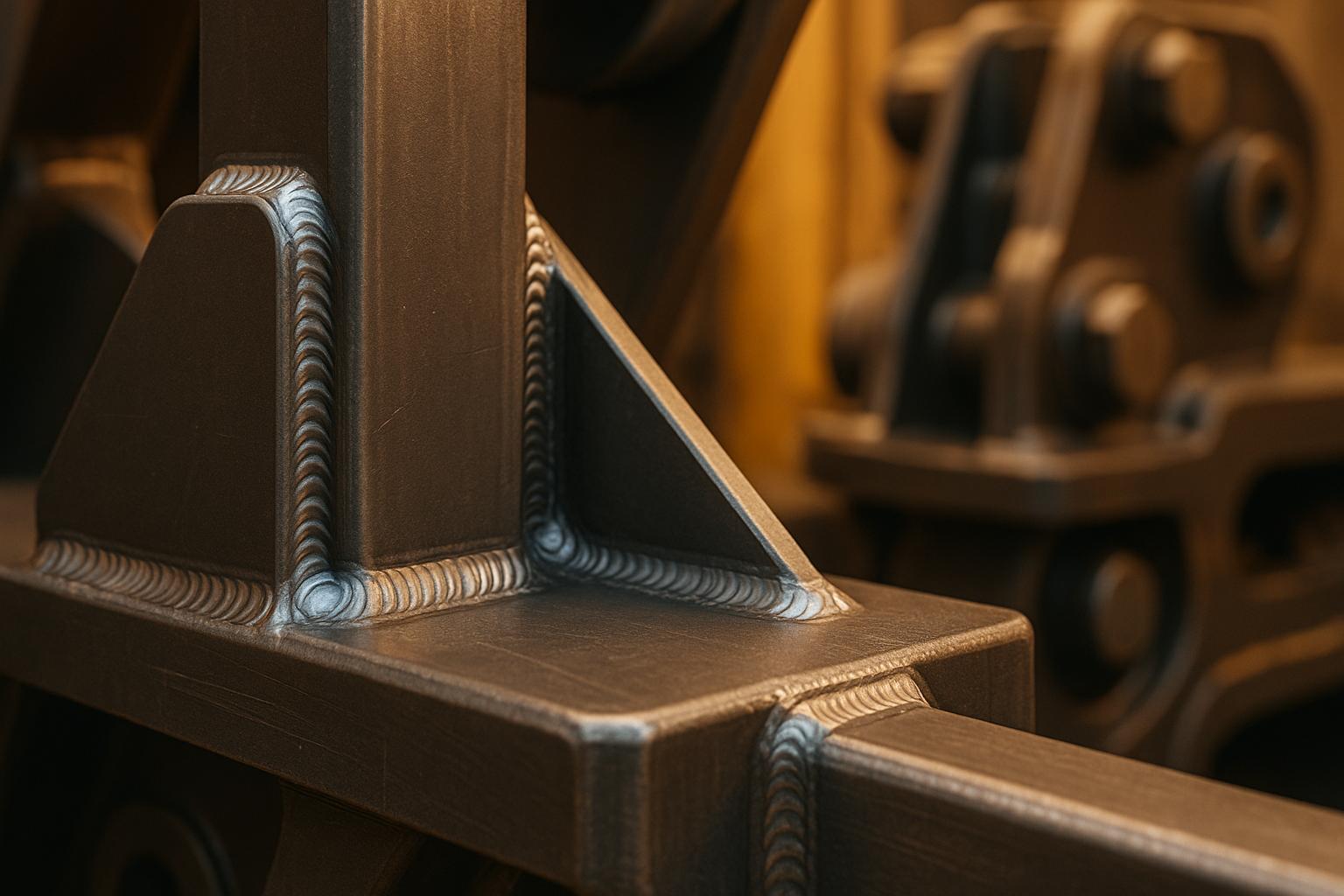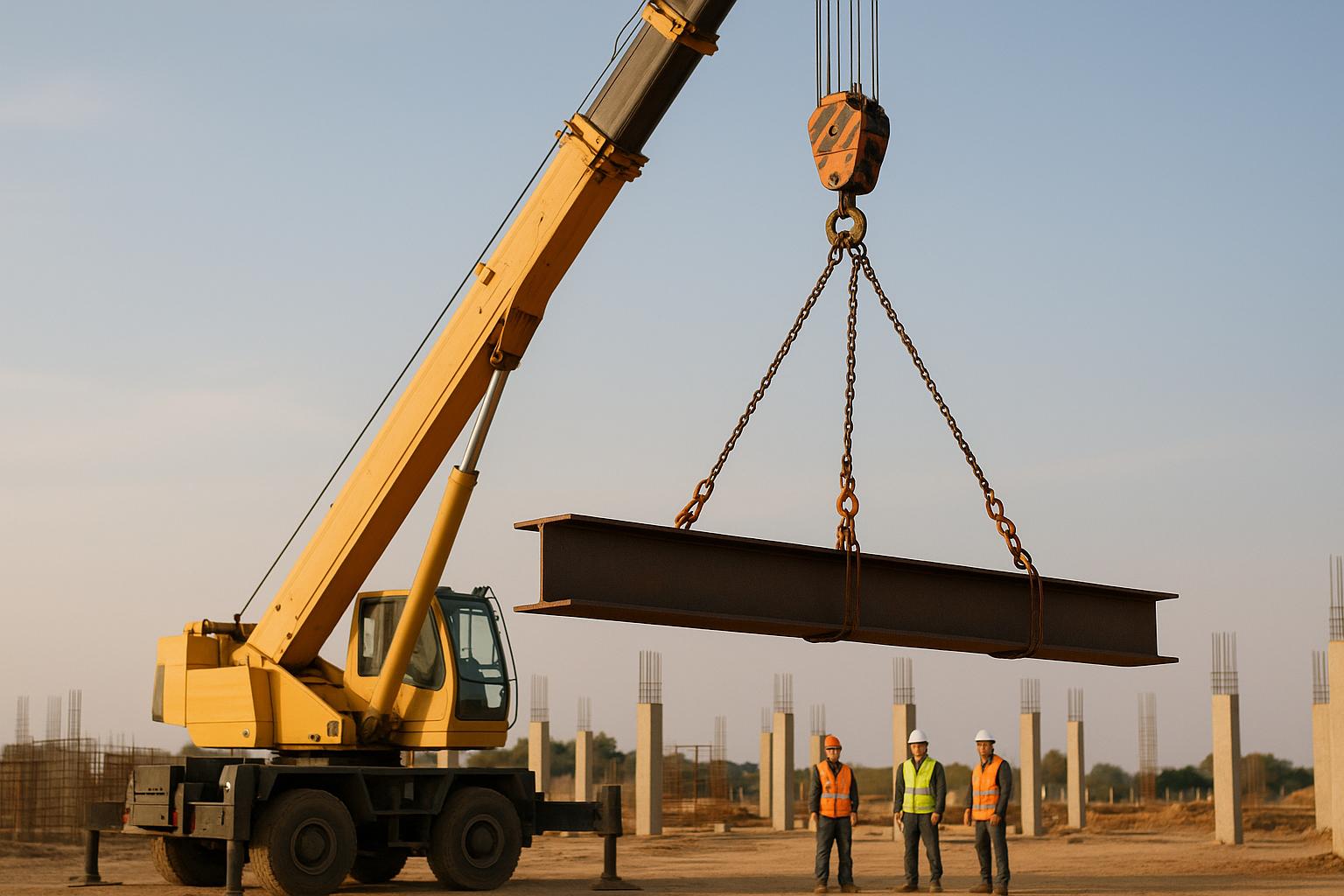How Structural Welding Impacts Equipment Durability

Structural welding is the backbone of durable heavy equipment. When done correctly, it creates joints stronger than the base materials, ensuring machinery can handle extreme stress, vibrations, and harsh conditions. Poor welds, however, lead to weak points, corrosion, and potential failures. High-quality welding not only extends equipment lifespan but also reduces maintenance and costs over time.
Key takeaways:
- Stronger Joints: Proper welding evenly distributes loads, reducing stress points.
- Corrosion Resistance: Quality welds seal gaps, protecting against rust and moisture.
- Cost Savings: Well-welded equipment requires up to 30% less maintenance.
- Common Methods: Stick, MIG, TIG, and Flux-Cored Arc Welding suit different needs.
- Inspection & Maintenance: Routine checks and non-destructive testing ensure reliability.
For heavy-duty applications, welding outperforms bolting or riveting in strength, durability, and long-term cost efficiency. Investing in skilled welders and precise techniques is crucial for safe, long-lasting equipment.
How Structural Welding Improves Equipment Durability
Better Structural Integrity
Structural welding fuses metal pieces into a unified structure capable of evenly distributing loads and withstanding intense forces. When done properly, the welded joint often surpasses the strength of the original base metals, reducing stress points that could otherwise fail. For heavy machinery like crane booms or excavator arms, this means greater reliability under constant pressure, with less chance of loosening or developing weak spots. This enhanced integrity not only ensures better load distribution but also reduces the impact of external factors on the welds. Companies like TDS Erectors & Crane Service leverage custom welding techniques to extend the lifespan of their equipment.
Protection from Environmental Damage
High-quality welds act as a shield against moisture, chemicals, and other contaminants that can lead to corrosion. By sealing gaps at the joint, proper welding prevents moisture infiltration and rust formation, significantly increasing the equipment's lifespan even in tough outdoor or industrial environments. This corrosion resistance also translates to lower maintenance costs over time, offering both durability and financial benefits.
Cost Savings from Longer-Lasting Equipment
Effective welding can cut maintenance needs by as much as 30% and help avoid expensive breakdowns that disrupt productivity. These cost savings are directly linked to the improved durability and resistance to environmental damage that quality welding provides. With routine maintenance, well-welded structures can last over 50 years, making the initial investment more worthwhile by extending the equipment's usable life.
Main Welding Techniques for Heavy Equipment Fabrication
Common Welding Methods
When it comes to heavy equipment fabrication, four welding techniques are widely used, each tailored to specific needs.
Stick Welding (SMAW) is a go-to method for outdoor repairs on thick steel. Its portability and ability to handle contaminants make it perfect for fieldwork, especially when deep penetration is required to ensure sturdy repairs.
MIG Welding (GMAW) shines in manufacturing settings where speed and consistency are non-negotiable. This process delivers clean, reliable welds on materials like mild and stainless steel, which is crucial for assembling heavy equipment efficiently.
TIG Welding (GTAW) is all about precision. It’s the top choice for critical components that demand flawless joints. Known for producing clean welds with minimal spatter, TIG welding works exceptionally well on thin materials and non-ferrous metals like aluminum, often used in specialized components.
Flux-Cored Arc Welding (FCAW) is built for heavy-duty tasks. Its ability to handle thick sections with high deposition rates and deep penetration makes it ideal for constructing large structural components that require strong and durable joints.
| Welding Method | Best Applications | Key Advantages | Typical Materials |
|---|---|---|---|
| Stick (SMAW) | Field repairs; thick steel | Portable; deep penetration | Structural and carbon steel |
| MIG (GMAW) | Production welding | Fast; consistent; clean | Mild steel; stainless steel |
| TIG (GTAW) | Precision work | High quality; minimal spatter | Aluminum; specialty alloys |
| FCAW | Heavy construction | High deposition; deep penetration | Thick steel sections |
To get the best results from these methods, certified welders and thorough quality checks are non-negotiable.
Need for Skilled Welders and Quality Control
The success of these welding techniques depends heavily on the expertise of certified welders and robust quality control processes. Poor welding practices can lead to defects like porosity, incomplete fusion, or cracks, all of which weaken structural integrity and pose safety risks. Certified welders, trained to meet AWS standards, follow strict procedures and undergo rigorous testing to ensure high-quality work.
Safety is another cornerstone of welding operations. OSHA regulations require welders to adhere to strict safety practices and obtain operator certification. For example, companies like TDS Erectors & Crane Service emphasize safety by employing OSHA-certified operators who undergo continuous training to maintain compliance and ensure safe operations.
Quality control plays a critical role in identifying and addressing potential issues before they escalate into costly failures. Techniques like visual inspections, non-destructive testing, and strict adherence to documented welding procedures help ensure that every weld meets the required standards. These measures not only enhance the durability and reliability of heavy equipment but also extend its service life.
How weak are terrible welds?
sbb-itb-6be7c12
Best Practices for High-Quality Welds
High-quality welds are essential for ensuring the durability and reliability of equipment, particularly in demanding applications. By following proven practices throughout the welding process, manufacturers can minimize the risk of equipment failures and extend the lifespan of their products.
Material Selection and Preparation
The foundation of a strong weld starts with choosing the right materials. Select metals and filler materials that are compatible, and ensure surfaces are clean and free of contaminants like rust, oil, or paint. These impurities can lead to porosity or incomplete fusion, weakening the weld. Metals such as carbon steel, stainless steel, and aluminum each have unique melting points and expansion properties, which need to be considered to maintain weld strength.
Proper alignment of parts is equally critical. Misaligned components can cause uneven heat distribution, leading to stress and cracking. Taking the time to align parts correctly results in stronger, more dependable joints.
For example, in heavy-duty crane construction, manufacturers often use high-strength, low-alloy steel paired with meticulous surface preparation. This combination consistently delivers welds capable of handling extreme loads and harsh environmental conditions. Companies like TDS Erectors & Crane Service emphasize these practices to produce equipment that meets rigorous standards for durability and performance.
Once materials are prepared, thorough inspection becomes the next vital step in ensuring weld quality.
Inspection and Testing
Inspection and testing are essential to identify potential flaws before they compromise the integrity of a weld. Non-destructive testing (NDT) methods, such as ultrasonic, radiographic, and magnetic particle testing, allow for the detection of defects without damaging the component.
- Ultrasonic Testing (UT): This method uses high-frequency sound waves to detect internal flaws like cracks or voids. It is especially effective for thick sections, which are common in heavy equipment manufacturing.
- Radiographic Inspection (X-ray): Provides detailed images that reveal hidden cracks, inclusions, and other internal issues.
- Magnetic Particle Testing (MT): Ideal for ferromagnetic materials, this technique quickly identifies surface and near-surface defects, such as fatigue cracks caused by high stress.
Research shows that welding defects account for up to 60% of structural failures in industrial settings. By implementing robust NDT protocols, manufacturers can detect issues early, preventing catastrophic failures and costly downtime.
Visual inspection also plays a key role as a preliminary check. Trained inspectors can identify visible defects like spatter, undercut, or surface cracks, which might indicate deeper problems requiring further analysis.
Regular Maintenance for Welded Joints
Even the best welds require ongoing care to ensure their longevity. Routine inspections, preventive cleaning, and applying protective coatings are all crucial steps in maintaining welded joints. Warning signs such as visible cracks, rust, deformation, or other signs of fatigue should be addressed promptly.
Repairing minor defects early prevents them from escalating under stress. Regular maintenance not only extends the life of welded joints but also protects the durability achieved through precise welding. Following manufacturer guidelines and adhering to industry-standard inspection schedules ensures that no detail is overlooked.
The shift toward preventive maintenance and scheduled inspections reflects a broader industry focus on maximizing equipment uptime and lowering overall lifecycle costs. Advances in inspection technologies, such as digital radiography and phased array ultrasonics, further enhance quality assurance in heavy equipment manufacturing, ensuring that welded components meet the highest standards.
Welded Joints vs Other Connection Methods
When it comes to building durable heavy equipment, manufacturers face a key decision: how to connect metal components. The choice of connection method - whether welding, bolting, or riveting - directly affects the equipment's strength, durability, and performance.
Strength and Durability Comparison
Welded joints create a strong, permanent bond by fusing metals together. This fusion often results in a connection that matches or even exceeds the strength of the base metals. Because the load is distributed more evenly across the joint, welded connections reduce stress concentrations that are common with other methods.
On the other hand, bolted and riveted joints rely on mechanical fasteners, which can concentrate stress around the holes needed for their installation. Over time, vibrations can loosen these fasteners, making them less reliable in high-stress applications. Welding’s ability to handle stress without weakening the joint makes it the go-to option when durability is a top priority.
While welding may require a higher initial investment in labor and equipment, it often proves more cost-effective in the long run. Welded joints demand less maintenance, experience fewer failures, and contribute to longer equipment lifespans. In contrast, bolted and riveted connections, though cheaper upfront, can lead to higher costs over time due to ongoing maintenance, part replacements, and potential downtime from joint failures.
| Connection Type | Strength | Stress Resistance | Maintenance Needs | Long-Term Cost Efficiency |
|---|---|---|---|---|
| Welded | High | High | Low | High |
| Bolted | Moderate | Moderate | Moderate-High | Moderate |
| Riveted | Moderate | Moderate-Low | High | Low-Moderate |
When to Choose Welding for Heavy Equipment
Given its durability and low maintenance needs, welding is the best choice for permanent, high-strength connections in critical structural components. This is especially true for custom fabrication projects where distributing loads evenly and minimizing weight are key priorities. Companies like TDS Erectors & Crane Service specialize in welding for demanding applications, ensuring dependable structures where joint failure is not an option.
Heavy equipment subjected to intense vibrations or dynamic loads benefits greatly from welded connections. For example, construction machinery frames, crane booms, and excavator arms endure repeated stress cycles that can loosen mechanical fasteners. Welded assemblies consistently outperform bolted ones in terms of durability and service life.
Welding also shines in situations involving complex geometries where mechanical fasteners are impractical. Custom ironwork, like structural steel frames, hand railings, and stair pans, relies on welding to achieve the necessary strength and precision.
That said, bolted or riveted joints have their place. They’re ideal when disassembly is needed for maintenance, transportation, or future modifications. These methods are also useful when welding isn’t feasible due to material limitations, thickness, or field conditions that make welding unsafe or inefficient.
Another advantage of welding is its ability to create seamless joints that eliminate gaps and crevices where moisture could accumulate. This makes it particularly valuable for equipment operating in harsh outdoor environments or corrosive conditions, where bolted or riveted connections might trap water and debris, accelerating wear and tear.
Conclusion and Key Takeaways
Structural welding plays a key role in ensuring the durability and reliability of heavy equipment. When done correctly, welds create bonds that are often stronger than the original materials, guaranteeing years - if not decades - of dependable performance.
The benefits go beyond just strength. High-quality welds minimize the need for frequent maintenance and repairs, leading to substantial savings over time. Unlike mechanical fasteners, welding produces permanent, seamless connections that are resistant to loosening, corrosion, and stress - common culprits behind joint failures.
Safety is another critical factor in heavy equipment operations. Welding defects like porosity, incomplete fusion, or cracks can lead to severe, even catastrophic, failures. By working with skilled professionals and adhering to rigorous inspection protocols, these risks can be dramatically reduced, preserving both structural integrity and operational safety.
For reliable results, consider partnering with experts such as TDS Erectors & Crane Service. Their OSHA-certified team ensures your equipment is built to last and performs safely under demanding conditions.
"Create high-quality, dependable, long-lasting structures with the help of our commercial welders." - TDS Erectors & Crane Service
In short, precise structural welding is the cornerstone of longevity, safety, and cost-effectiveness in heavy equipment.
FAQs
How does structural welding improve the durability and lifespan of heavy equipment?
Structural welding is a key factor in maintaining the strength and durability of heavy equipment. When done correctly, it creates solid, seamless joints capable of handling heavy loads, constant vibrations, and tough working conditions. This helps prevent cracks, weak spots, and potential failures over time.
To ensure top-notch results, the right welding techniques, high-quality materials, and experienced professionals are crucial. For example, companies like TDS Erectors & Crane Service focus on precision and safety in their commercial fabrication and welding work, ensuring equipment operates reliably. Choosing skilled welding services can add years to your equipment's lifespan while reducing costly downtime from repairs or breakdowns.
What are the warning signs of poor welding that could weaken equipment durability?
Poor welding can seriously weaken heavy equipment, reducing its strength and lifespan. Some clear red flags to watch out for include visible cracks, uneven weld beads, and porosity - those tiny holes or voids in the weld. You might also spot weak joints or undercutting, where the edges of the base metal look gouged or eroded along the weld line. These issues can compromise the structure and even lead to equipment failure.
To keep your equipment reliable and long-lasting, it’s essential to tackle these problems right away. Trusting skilled professionals for structural welding and sticking to high-quality welding practices are key steps to preserving your equipment's integrity.
Why are regular inspections and maintenance essential for welded joints in heavy equipment?
Regularly inspecting and maintaining welded joints is key to keeping heavy equipment safe, durable, and reliable. Over time, these joints can face stress, fatigue, or wear from environmental factors, which might lead to cracks or weaknesses if not addressed.
Catching potential problems early can save you from expensive repairs, equipment breakdowns, or even safety risks. Consistent maintenance not only prevents issues but also helps extend the life of your equipment, ensuring it stays dependable and functional even in tough working conditions. Routine checks are your best bet for keeping everything running smoothly.
Related Blog Posts
Blogs, calculators, and other content on the TDS blog is for educational purposes only and does not constitute crane or rigging advice. For information specific to your situation, please contact us for an estimate or consultation.
Related Articles

How to Calculate Crane Lifting Capacity Safely
Learn how to safely calculate crane lifting capacity by understanding key factors, reading load charts, and adhering to safety protocols.

5 Essential Crane Safety Tips for Construction Sites
Learn essential crane safety tips to prevent accidents and ensure safe operations on construction sites, protecting both workers and equipment.

What Does OSHA Require for Crane Operators?
Learn about OSHA's requirements for crane operators, including certification, training, inspections, and documentation to ensure workplace safety.
